Researcher:
Håkan Nilsson
hani@chalmers.se
Project leader: Lars Davidson lada@chalmers.se
Cooperation:
GE Energy (Sweden) AB,
GE Energy (Norway) AS,
Financing:
The Swedish National Energy Admininstration,
GE Energy (Sweden) AB and
the Swedish electrical utilities R&D company
Publications: [], see references below
Start of project : Autumn 2003
End of project : 2008

Keywords:
CFD, Finite Volume, Numerical, Turbulence, Parallel, Multiblock, Kaplan, Francis, Turbine, Turbomachinery, Tip Clearance, Validation, Verification, Visualization, Cavitation, Volume of Fluid, VOF
INTRODUCTION
 This work is part of a Swedish water turbine program financed by a collaboration between the Swedish power industry via ELFORSK (Swedish Electrical Utilities Research and Development Company), the Swedish National Energy Administration and GE Energy (Sweden) AB. The purpose of the Swedish water turbine program is to increase Swedish water power competence in order to meet the growing water power demand in Sweden and demands on preservation of the environment and efficiency.
This work is part of a Swedish water turbine program financed by a collaboration between the Swedish power industry via ELFORSK (Swedish Electrical Utilities Research and Development Company), the Swedish National Energy Administration and GE Energy (Sweden) AB. The purpose of the Swedish water turbine program is to increase Swedish water power competence in order to meet the growing water power demand in Sweden and demands on preservation of the environment and efficiency.
The aim of the present project is to implement existing cavitation models in the CALC-PMB CFD code and to validate the computational results against observations. Further on improvements to the cavitation models will be implemented.
NUMERICAL CONSIDERATIONS
The main features of the CALC-PMB CFD code are the use of conformal block structured boundary fitted coordinates, a pressure correction scheme (SIMPLEC), cartesian velocity components as the principal unknowns, and collocated grid arrangement together with Rhie and Chow interpolation. The computational blocks are solved in parallel with Dirichlet-Dirichlet coupling using PVM (Parallel Virtual Machine) or MPI (Message Passing Interface). During the computations, the computational blocks are assigned to separate PVM or MPI processes. The level of parallelization is thus determined by the block size distribution and the distribution of the processes on the available processors. The parallel efficiency is excellent, with super scalar speedup for load balanced applications. The ICEM CFD/CAE grid generator is used for grid generation and Ensight, Tecplot and Matlab are used for post-processing.
Since we are developing the code ourselves, we are in full control of numerical errors, assumed approximations, etc. We can easily implement new turbulence models or use Large Eddy Simulations (LES) with different subgrid models.
RESULTS
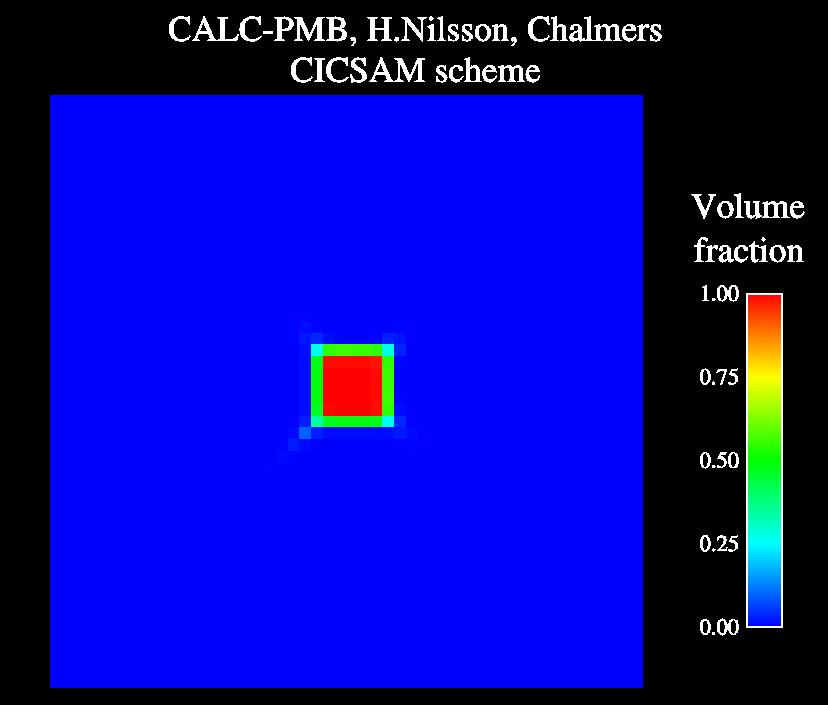
|
The CICSAM scheme is under implementation and verification in CALC-PMB. This figure shows results from CALC-PMB for a square being advected diagonally (lower left to upper right) through a cartesian mesh (50x50 cells). The mesh size is the same as the green region. Try to run the mpeg-movie by clicking on the figure.
|
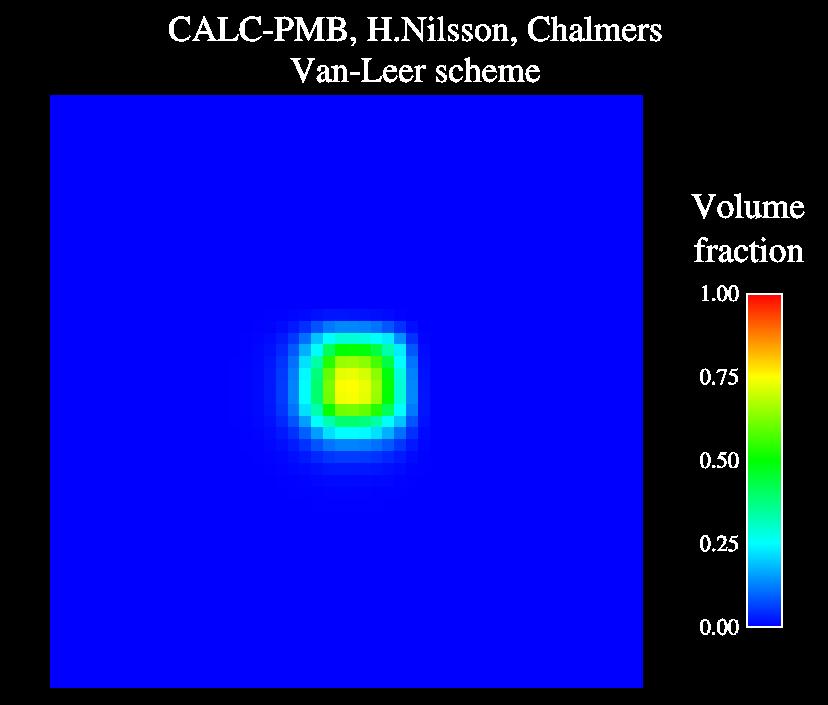
|
This figure shows the same results as those above, but using the Van-Leer discretization scheme. Try to run the mpeg-movie by clicking on the figure.
|
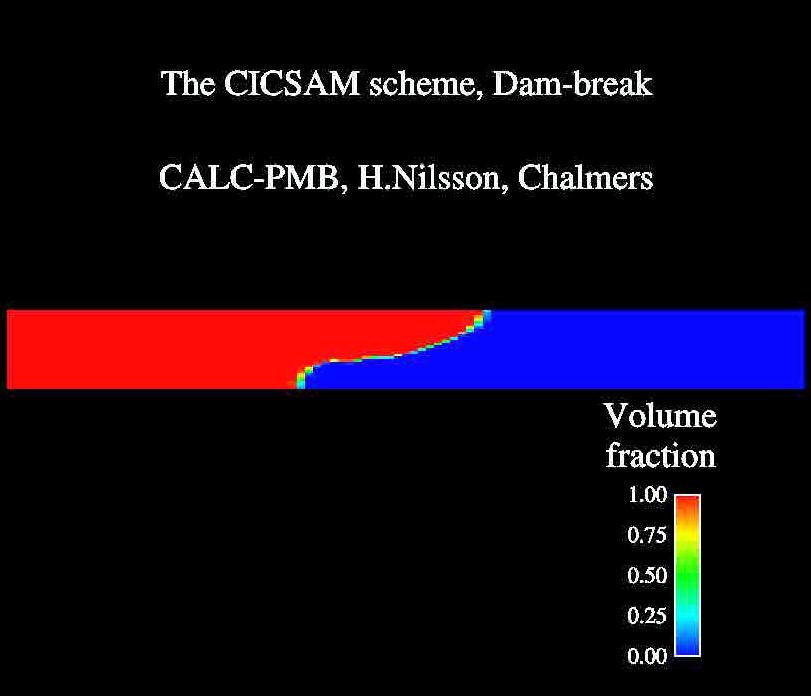
|
Dam-break (actually lock-exchange): At start the barrier between the light
fluid at the left of the center (red) and the heavy fluid at the right
of the center is removed. The density ratio is 2. The colors are the
volume fraction of the lighter fluid. The CICSAM scheme is used for the discretization of the volume fraction equation. Try to run the mpeg-movie by clicking on the figure.
|
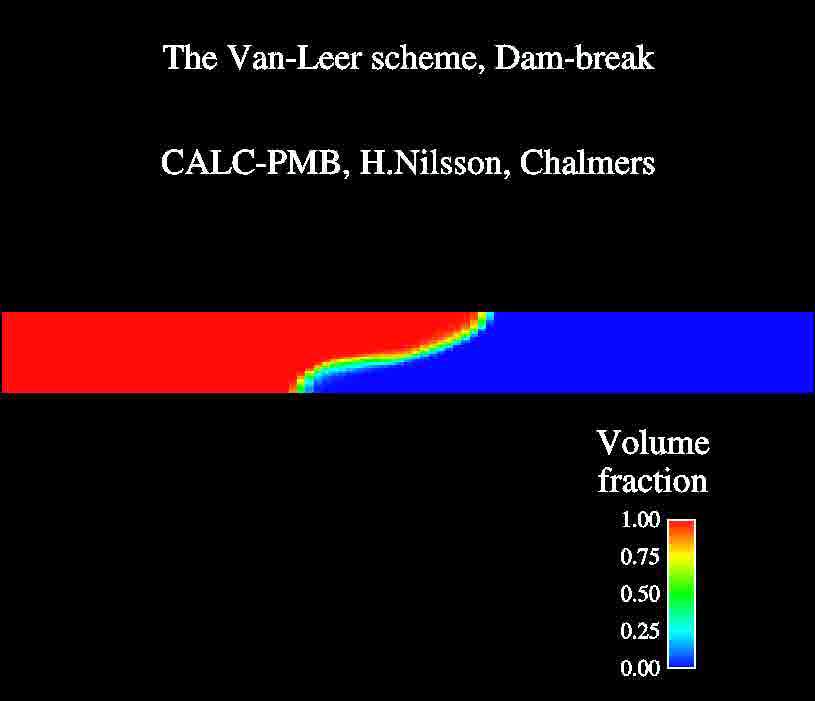
|
The same as the above, but the Van-Leer scheme is used for the discretization of the volume fraction equation. Try to run the mpeg-movie by clicking on the figure.
|
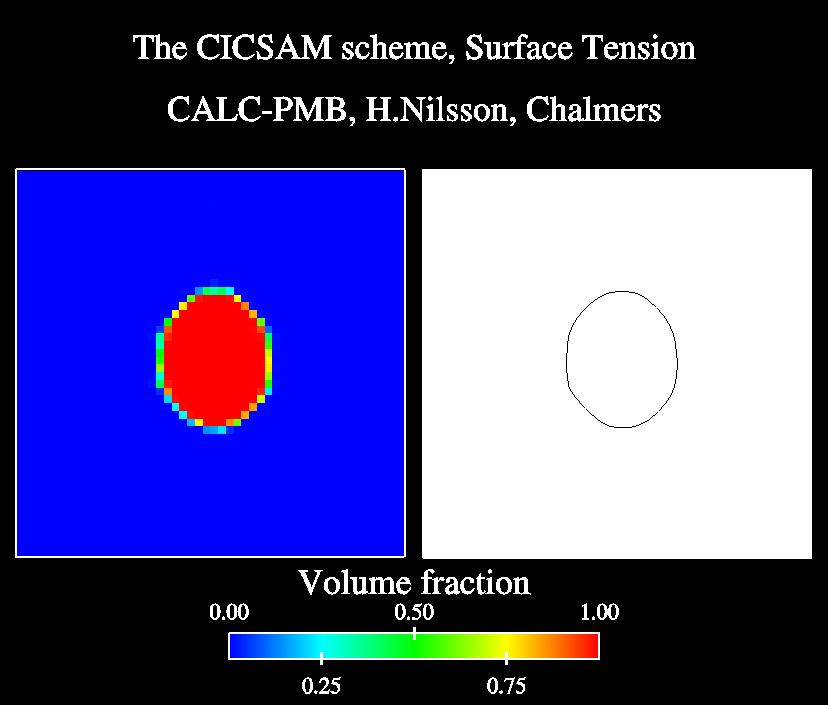
|
A rectangular initial volume fraction distribution is used as a test case when implementing surface tension in CALC-PMB. The CICSAM scheme is used for the discretization of the volume fraction equation. Try to run the mpeg-movie by clicking on the figure.
|
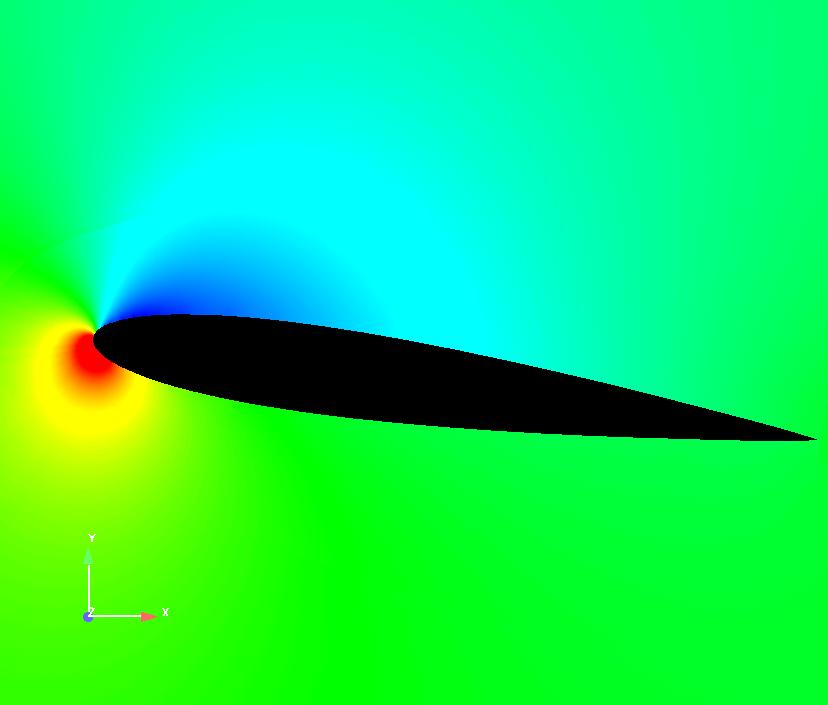
|
Steady 2D computation of the turbulent flow around a wing profile at 8 degree angle of attack. Water at free stream velocity 12m/s. Re=12000
based on the length of the wing.
Low-Re k-omega turbulence model. Colors are static pressure, where red is high and blue is low.
|
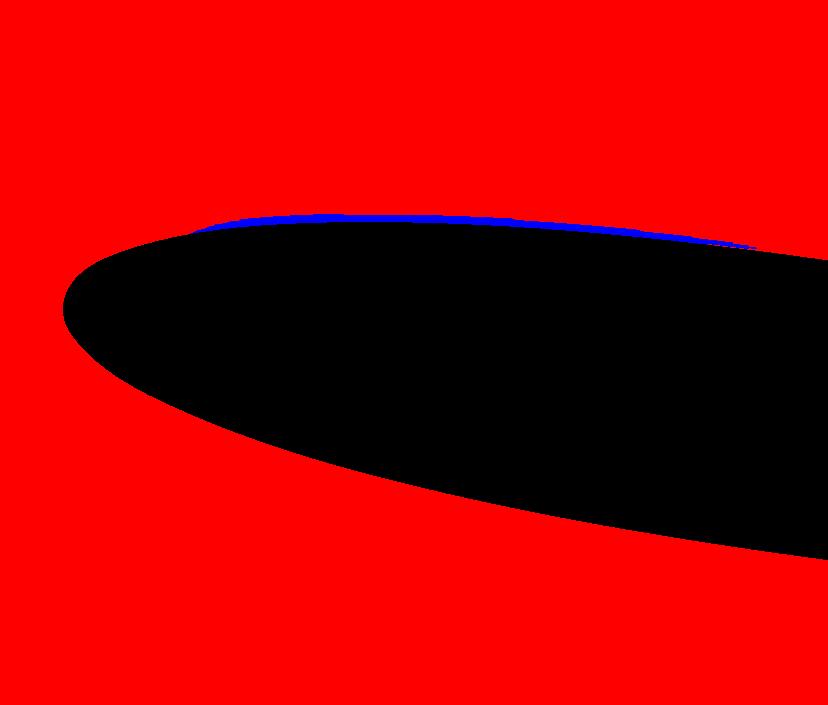
|
Steady 2D computation of the turbulent flow around a wing profile at 8 degree angle of attack. Water at free stream velocity 12m/s. Re=1 200 000
based on the length of the wing. Low-Re k-omega turbulence model. Colors are 'color function', where red is pure water and blue is not pure water (color function below 1). Note that the surface has been
sharpened in post processing, the blue area is only slightly
affected by the cavitation model. Density ratio = 2. No VOF surface sharpening method!
|
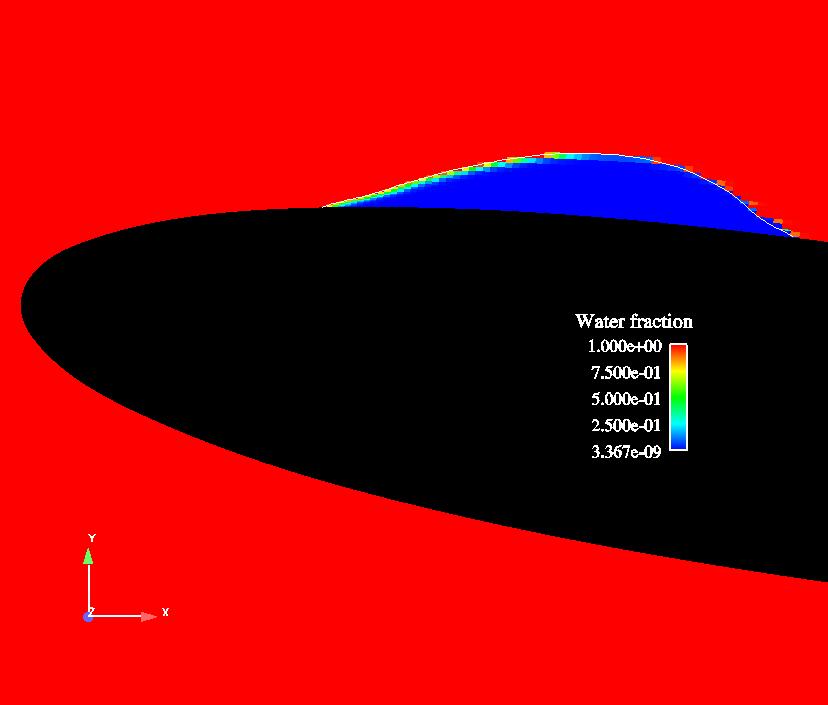
|
Preliminary 2D computation of the turbulent flow around a wing profile at 8 degree angle of attack. Water at free stream velocity 5m/s. Re=500 000
based on the length of the wing. k-omega turbulence model. Colors are 'color function', where red is pure water above the vaporization pressure and blue is also water but below the vaporization pressure. An iso-curve for the chosen vaporization pressure is shown as a white line. The color function is computed by a separate transport equation with a source term for vaporization/condensation. Density ratio = 1, i.e. the flow is not affected. No VOF surface sharpening method!
|
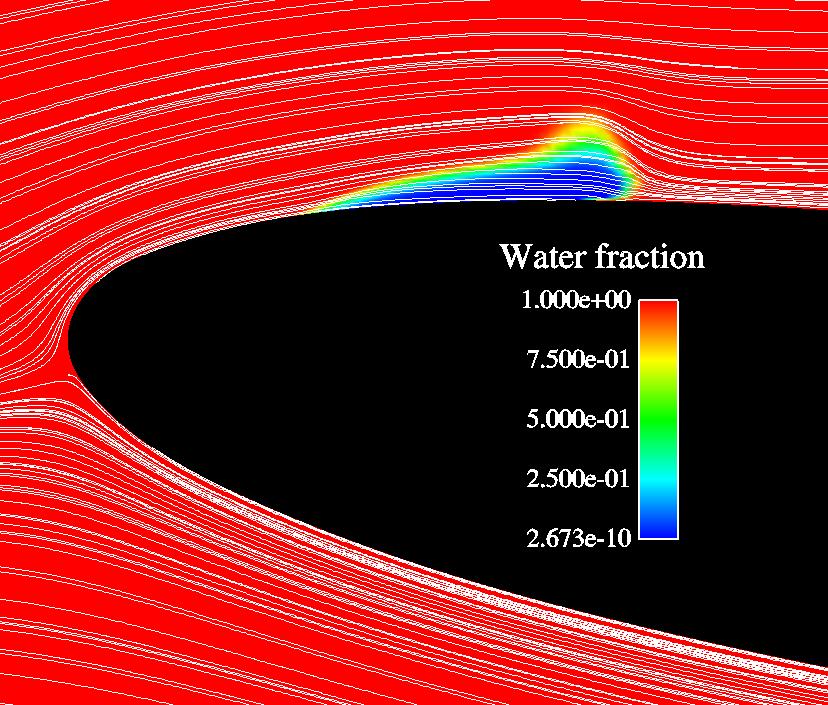
|
Preliminary (non-converged, iteration snapshot) 2D computation of the cavitating turbulent flow around a wing profile at 8 degree angle of attack. Water at free stream velocity 5m/s. Re=500 000
based on the length of the wing. k-omega turbulence model. Colors are 'color function', where red is pure water and blue is vapour. Streamlines show the effect of the cavity. Density ratio = 2. No VOF surface sharpening method!
|
DISCUSSION
The introduction of CFD in the area of hydraulic machine research is believed to increase a detailed knowledge of the flow inside the machines and to speed up the design procedure. This requires that the experience from CFD in this area is increased, which cannot be achieved without detailed experimental investigations to be used for comparisons. With sufficient experience of CFD in the area of hydraulic machine research, CFD will definitely be used in future hydraulic machine development.
Academic cooperation:
Professor G. Bark at the department of Naval Architecture at Chalmers
Industrial cooperation:
GE Energy (Sweden) AB and GE Energy (Norway) AS.
International cooperation:
Just established
Status:
Just started








